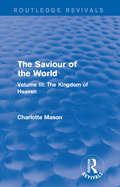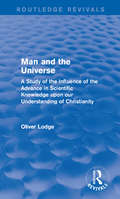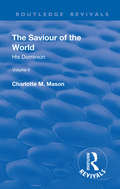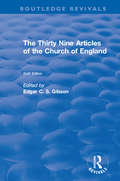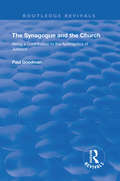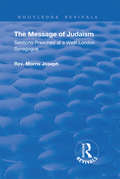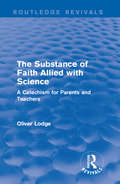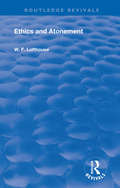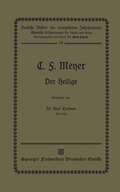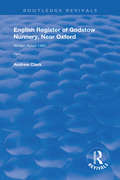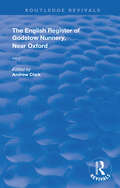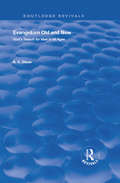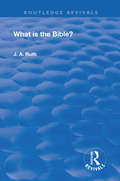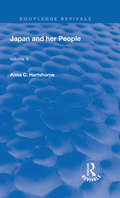- Table View
- List View
The Saviour of the World: Volume III: The Kingdom of Heaven (Routledge Revivals)
by Charlotte M MasonThe Saviour of the World covers each incident and each saying in the Bible and converts them to either a single poem, blank verse or rhymed stanza, according to the subject. This volume, called The Kingdom of Heaven, was originally published in 1909. This book will be of interest to students of both religious studies and English literature.
Man and the Universe: A Study of the Influence of the Advance in Scientific Knowledge upon our Understanding of Christianity (Routledge Revivals)
by Oliver LodgeOriginally published in 1908, Lodge applies his background in physics to the study of Christian Theology. He aims to reconcile religious doctrine to scientific theory, calling for a re-interpretation of biblical texts to allow for the integration of science while simultaneously making a case for the acceptance of miracles in the scientific community. This title will be of interest to students of Religious Studies as well as to general readers interested in problems of existence.
Man and the Universe: A Study of the Influence of the Advance in Scientific Knowledge upon our Understanding of Christianity (Routledge Revivals)
by Oliver LodgeOriginally published in 1908, Lodge applies his background in physics to the study of Christian Theology. He aims to reconcile religious doctrine to scientific theory, calling for a re-interpretation of biblical texts to allow for the integration of science while simultaneously making a case for the acceptance of miracles in the scientific community. This title will be of interest to students of Religious Studies as well as to general readers interested in problems of existence.
Revival: His Dominion (Routledge Revivals)
by Charlotte M. MasonSOME OPINIONS OF THE PRESS ON "THE SAVIOUR OF THE WORLD" VOL. II. HIS DOMINIONThese reviews/comments followed the original release of His Dominion in 1908.Miss Charlotte Mason has now given us the second instalment of her elaborate work in verse on "The Saviour of the World." . . . Miss Mason renders into graceful and original verse part of the story of Christ as found in the Gospels. She seeks to cover each incident in His career, and each notable saying to which He gave utterance, in a single poem, the series to form a complete story. Her obvious sincerity and the high aim which is everywhere apparent make her pleasing verses singularly attractive. She is reverent throughout and always dignified.—Dundee AdvertiserMiss Mason has much of the subtle skill of Browning, and her effusions breathe everywhere a spirit of deep devotion to "The Saviour of Mankind."—Catholic TimesMiss Mason's gracefully versified tractate in Christian theology—for that is what the poem is—should be read without weariness by the devout . . . On its literary side the book will readily evoke the admiration and sympathy of readers who like to have familiar lessons of Christianity refreshed by good workmanship in metrical art.—ScotsmanThe first volume met with a very cordial reception, and now the talented authoress gives her second volume to the world. . . . The authoress employs the choicest language, and shows great skill in versification. The whole work, in fact, aims at giving the whole of the Gospel story in verse—not a small task, by any means, but one for which Miss Mason seems to be specially endowed.—Western MailMiss Mason here continues what she modestly describes as a "paraphrase in verse" of the Gospel story. As the writer aptly remarks, such a theme as this, in its sacred utterances and dramatic situations, finds a better medium of presentation in poetry than in prose. The first stage or act of the inspired narrative, The Holy Infancy, being completed, Miss Mason passes on to the Ministry of Our Lord at its commencement and first teaching (Sermon on the Mount and earlier parables), and first miracles . . . the sequence of the work is marked no less by the skill of the author than by the reverent spirit in which it is composed. Echoes of George Herbert and of Isaac Williams are to be caught here and there in the various pieces, as. E.g. where paraphrasing a passage in the Sermon on the Mount, Miss Mason writes: —"Nay, keep thy soul at eve,Nor e'er perceiveThe heavy odour of an unchaste thought."It would be difficult to express better the "atmosphere" of the new Paradise "regained" by Christ in place of that which was lost. —BooksellerThe same careful, reverent handling of holy things characterises this new volume, which, like the former, is a paraphrase, in blank verse chiefly, of the Gospel narrative.—Guardian
Revival: His Dominion (Routledge Revivals)
by Charlotte M. MasonSOME OPINIONS OF THE PRESS ON "THE SAVIOUR OF THE WORLD" VOL. II. HIS DOMINIONThese reviews/comments followed the original release of His Dominion in 1908.Miss Charlotte Mason has now given us the second instalment of her elaborate work in verse on "The Saviour of the World." . . . Miss Mason renders into graceful and original verse part of the story of Christ as found in the Gospels. She seeks to cover each incident in His career, and each notable saying to which He gave utterance, in a single poem, the series to form a complete story. Her obvious sincerity and the high aim which is everywhere apparent make her pleasing verses singularly attractive. She is reverent throughout and always dignified.—Dundee AdvertiserMiss Mason has much of the subtle skill of Browning, and her effusions breathe everywhere a spirit of deep devotion to "The Saviour of Mankind."—Catholic TimesMiss Mason's gracefully versified tractate in Christian theology—for that is what the poem is—should be read without weariness by the devout . . . On its literary side the book will readily evoke the admiration and sympathy of readers who like to have familiar lessons of Christianity refreshed by good workmanship in metrical art.—ScotsmanThe first volume met with a very cordial reception, and now the talented authoress gives her second volume to the world. . . . The authoress employs the choicest language, and shows great skill in versification. The whole work, in fact, aims at giving the whole of the Gospel story in verse—not a small task, by any means, but one for which Miss Mason seems to be specially endowed.—Western MailMiss Mason here continues what she modestly describes as a "paraphrase in verse" of the Gospel story. As the writer aptly remarks, such a theme as this, in its sacred utterances and dramatic situations, finds a better medium of presentation in poetry than in prose. The first stage or act of the inspired narrative, The Holy Infancy, being completed, Miss Mason passes on to the Ministry of Our Lord at its commencement and first teaching (Sermon on the Mount and earlier parables), and first miracles . . . the sequence of the work is marked no less by the skill of the author than by the reverent spirit in which it is composed. Echoes of George Herbert and of Isaac Williams are to be caught here and there in the various pieces, as. E.g. where paraphrasing a passage in the Sermon on the Mount, Miss Mason writes: —"Nay, keep thy soul at eve,Nor e'er perceiveThe heavy odour of an unchaste thought."It would be difficult to express better the "atmosphere" of the new Paradise "regained" by Christ in place of that which was lost. —BooksellerThe same careful, reverent handling of holy things characterises this new volume, which, like the former, is a paraphrase, in blank verse chiefly, of the Gospel narrative.—Guardian
Revival: The Thirty Nine Articles of the Church of England (Routledge Revivals)
by EDGAR C. S. GIBSON, D.D.This book is a revival of The Thirty-Nine Articles of the Church of England, explained with an introduction by Edgar C.S. Gibson. The Articles themselves are the historically defining statements of doctrines and practices of the Church of England with respect to the controversies of the English Reformation. The Thirty-Nine Articles form part of the Book of Common Prayer used by both the Church of England and the Episcopal Church. They were finalised in 1571, and incorporated into the Book of Common Prayer. The book helped to standarize the English language, and was to have a lasting effect on religion in the United Kingdom, and elsewhere through its wide use
Revival: The Thirty Nine Articles of the Church of England (Routledge Revivals)
by Edgar C. S. GibsonThis book is a revival of The Thirty-Nine Articles of the Church of England, explained with an introduction by Edgar C.S. Gibson. The Articles themselves are the historically defining statements of doctrines and practices of the Church of England with respect to the controversies of the English Reformation. The Thirty-Nine Articles form part of the Book of Common Prayer used by both the Church of England and the Episcopal Church. They were finalised in 1571, and incorporated into the Book of Common Prayer. The book helped to standarize the English language, and was to have a lasting effect on religion in the United Kingdom, and elsewhere through its wide use
The Synagogue and the Church: BEING A CONTRIBUTION TO THE APOLOGETICS OF JUDAISM (Routledge Revivals)
by Paul GoodmanPublished in 1908, this book details the development and establishment of Judaism and Jewish culture in contrast to the spread and presence of the Christian church and community. Focusing on the spiritual importance of Jewish scripture and its prominence in other Abrahamic religions, Goodman presents a discussion on spiritual and ethical perspectives in Judaism in comparison to Christianity.
The Synagogue and the Church: BEING A CONTRIBUTION TO THE APOLOGETICS OF JUDAISM (Routledge Revivals)
by Paul GoodmanPublished in 1908, this book details the development and establishment of Judaism and Jewish culture in contrast to the spread and presence of the Christian church and community. Focusing on the spiritual importance of Jewish scripture and its prominence in other Abrahamic religions, Goodman presents a discussion on spiritual and ethical perspectives in Judaism in comparison to Christianity.
The Message of Judaism: Sermons Preached at a West London Synagogue (Routledge Revivals)
by Morris JosephPublished in 1908, this book draws on a variety of sermons written by Rev. Morris Josephs, to provide a message on Judaism. Designed to create a discourse for universal readership this book covers topics such as the ethics of Jewish life, the perception of the world vs Judaism, and the religious experience of Judaism.
The Message of Judaism: Sermons Preached at a West London Synagogue (Routledge Revivals)
by Morris JosephPublished in 1908, this book draws on a variety of sermons written by Rev. Morris Josephs, to provide a message on Judaism. Designed to create a discourse for universal readership this book covers topics such as the ethics of Jewish life, the perception of the world vs Judaism, and the religious experience of Judaism.
The Substance of Faith Allied with Science: A Catechism for Parents and Teachers (Routledge Revivals)
by Oliver LodgeOriginally published in 1907, this book provides information to parents and teachers wishing to teach their children about Christianity as well as science. Lodge details his fear of mandatory secularism in schools and advises how to instruct children in science without allowing any doubt of Christian doctrine and stresses the importance of reconciliation between religion and science for future generations. This title will be of interest to students of Education and Religion.
The Substance of Faith Allied with Science: A Catechism for Parents and Teachers (Routledge Revivals)
by Oliver LodgeOriginally published in 1907, this book provides information to parents and teachers wishing to teach their children about Christianity as well as science. Lodge details his fear of mandatory secularism in schools and advises how to instruct children in science without allowing any doubt of Christian doctrine and stresses the importance of reconciliation between religion and science for future generations. This title will be of interest to students of Education and Religion.
Ethics & Atonement (Routledge Revivals)
by W.F. LofthouseFirst published in 1906, this book considers the concept of atonement and suggest that the doctrine of atonement is not an artificial theorem or an inexplicable or unethical dogma, but that it has roots in the foundations of all human life. Lofthouse further argues that the doctrine of atonement is the highest expression of the law of all moral and social progress; and that ethics in itself is of little use as a practical science, unless completed by atonement.
Ethics & Atonement (Routledge Revivals)
by W.F. LofthouseFirst published in 1906, this book considers the concept of atonement and suggest that the doctrine of atonement is not an artificial theorem or an inexplicable or unethical dogma, but that it has roots in the foundations of all human life. Lofthouse further argues that the doctrine of atonement is the highest expression of the law of all moral and social progress; and that ethics in itself is of little use as a practical science, unless completed by atonement.
English Register of Godstow Nunnery, Near Oxford: Part I (Routledge Revivals)
by Andrew ClarkFirst published in 1905, these two volumes together reproduced the text of Rawlinson MS. B 408 from the Bodleian Library in two parts. They consist of a preface followed the full Middle English text with glosses. The initial section of the manuscript is slightly older and consists of prefixed liturgical pieces such as the Articles of Excommunication. This follows the common historical practice of combining manuscripts to encourage their preservation. The remainder of the text presents the reader with the Register of the Estates of Godstow Abbey. The manuscript was initially created as a translation of the Latin register in order to allow the nuns, who were literate in English but not Latin, to manage their own estates. This manuscript was, at the time of publication, the only known complete English-language cartulary made for a monastic house. It holds significant implications not only for the status, linguistic development and usage of the English language, but also for women’s history in the church and their socioeconomic agency, along with the ability of language to both restrict and open doors. The text includes its own introduction in which the founding of the Abbey by Dame Edyve of Winchester, first Abbess of Godstow, is recounted, followed by deeds relating to the local area.
English Register of Godstow Nunnery, Near Oxford: Part I (Routledge Revivals)
by Andrew ClarkFirst published in 1905, these two volumes together reproduced the text of Rawlinson MS. B 408 from the Bodleian Library in two parts. They consist of a preface followed the full Middle English text with glosses. The initial section of the manuscript is slightly older and consists of prefixed liturgical pieces such as the Articles of Excommunication. This follows the common historical practice of combining manuscripts to encourage their preservation. The remainder of the text presents the reader with the Register of the Estates of Godstow Abbey. The manuscript was initially created as a translation of the Latin register in order to allow the nuns, who were literate in English but not Latin, to manage their own estates. This manuscript was, at the time of publication, the only known complete English-language cartulary made for a monastic house. It holds significant implications not only for the status, linguistic development and usage of the English language, but also for women’s history in the church and their socioeconomic agency, along with the ability of language to both restrict and open doors. The text includes its own introduction in which the founding of the Abbey by Dame Edyve of Winchester, first Abbess of Godstow, is recounted, followed by deeds relating to the local area.
English Register of Godstow Nunnery, Near Oxford: Part II (Routledge Revivals)
by Andrew ClarkFirst published in 1905, these two volumes together reproduced the text of Rawlinson MS. B 408 from the Bodleian Library in two parts. They consist of a preface followed the full Middle English text with glosses. The initial section of the manuscript is slightly older and consists of prefixed liturgical pieces such as the Articles of Excommunication. This follows the common historical practice of combining manuscripts to encourage their preservation. The remainder of the text presents the reader with the Register of the Estates of Godstow Abbey. The manuscript was initially created as a translation of the Latin register in order to allow the nuns, who were literate in English but not Latin, to manage their own estates. This manuscript was, at the time of publication, the only known complete English-language cartulary made for a monastic house. It holds significant implications not only for the status, linguistic development and usage of the English language, but also for women’s history in the church and their socioeconomic agency, along with the ability of language to both restrict and open doors. The text includes its own introduction in which the founding of the Abbey by Dame Edyve of Winchester, first Abbess of Godstow, is recounted, followed by deeds relating to the local area.
Evangelism Old and New: God's Search For Man in All Ages (Routledge Revivals)
by Amzi Clarence DixonPublished in 1905: This book discusses Evangelism and Christianity.
Evangelism Old and New: God's Search For Man in All Ages (Routledge Revivals)
by Amzi Clarence DixonPublished in 1905: This book discusses Evangelism and Christianity.
What is the Bible? (Routledge Revivals)
by J.A. RuthFirst published in 1904, this volume questioned whether the Bible is in its entirety the literal Word of God. The author’s strong background in evangelical Christianity led them to question numerous theological experts and ministers on the topic and conclude that the Bible is as purely and entirely a human production as any other work of literature. Ruth argues instead that humanity’s knowledge of God has come about through developing the faculties with which God has endowed them and that the Bible is a history of humanity’s discovery of God. First considering whether the Bible can be considered the Word of God, the author moves on to cover topics including the evolution of Hebrew monotheism, the Bible canon, contraditions and miracles.
What is the Bible? (Routledge Revivals)
by J.A. RuthFirst published in 1904, this volume questioned whether the Bible is in its entirety the literal Word of God. The author’s strong background in evangelical Christianity led them to question numerous theological experts and ministers on the topic and conclude that the Bible is as purely and entirely a human production as any other work of literature. Ruth argues instead that humanity’s knowledge of God has come about through developing the faculties with which God has endowed them and that the Bible is a history of humanity’s discovery of God. First considering whether the Bible can be considered the Word of God, the author moves on to cover topics including the evolution of Hebrew monotheism, the Bible canon, contraditions and miracles.
Japan and Her People: Vol. II (Routledge Revivals)
by Anna C. HartshorneThis book provides an overview of Japan in late 19th century and its history. It also provides an insight of Japanese society as it moved from the traditional Edo period lifestyle towards industrialization and explores Japan's lifestyles, customs, culture, and everyday behavior.
Japan and Her People: Vol. II (Routledge Revivals)
by Anna C. HartshorneThis book provides an overview of Japan in late 19th century and its history. It also provides an insight of Japanese society as it moved from the traditional Edo period lifestyle towards industrialization and explores Japan's lifestyles, customs, culture, and everyday behavior.
